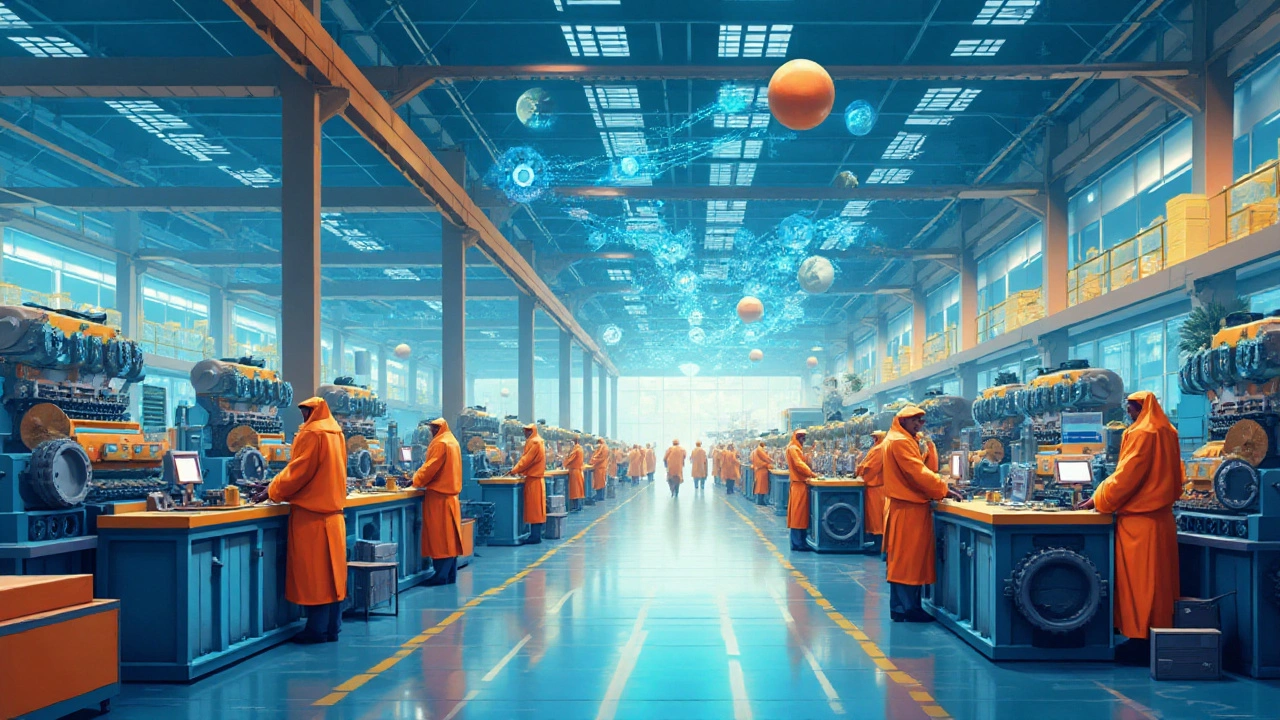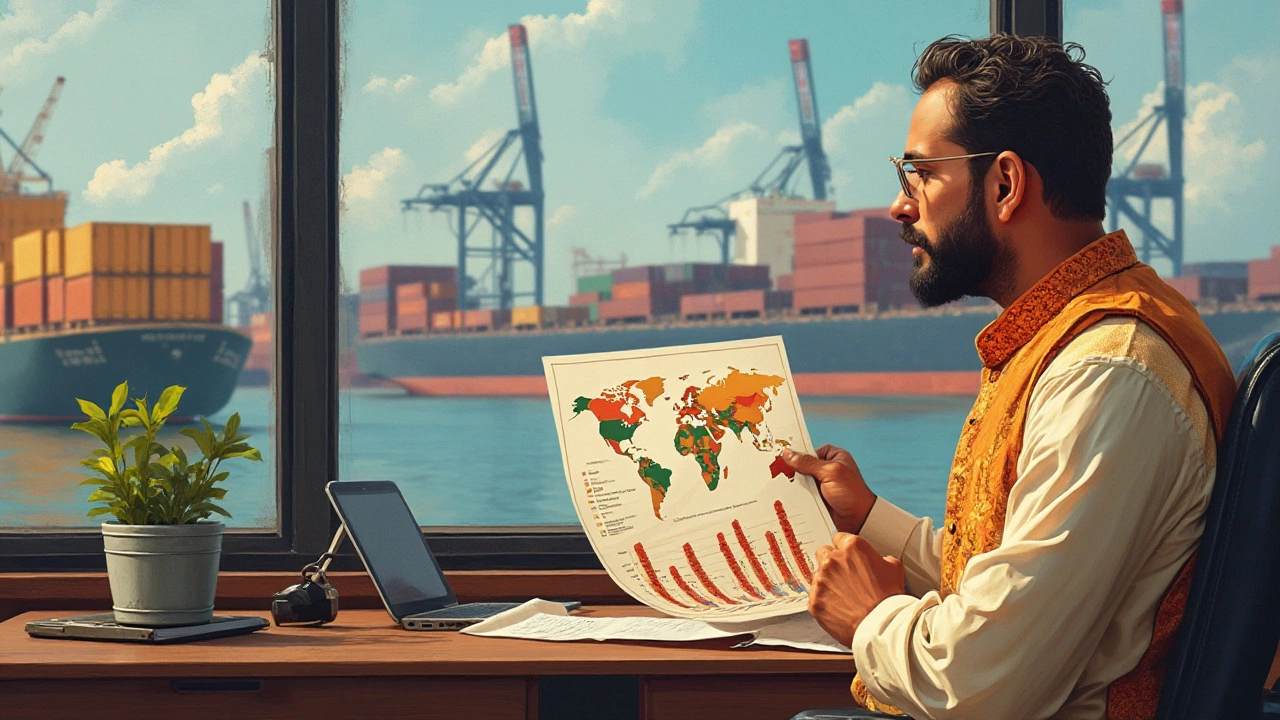 Jan, 31 2025
Jan, 31 2025
The world of plastic production and export is both vast and vital, influencing global economies and industries. Every day, massive quantities of plastics are traded internationally, supporting countless businesses. But who stands atop this complex web as the biggest exporter?
This article will unearth the current leaders in the plastic export arena, examining the elements that fuel their success. As we explore these powerhouses, we'll also touch upon how their export strategies mesh with global environmental efforts. With new trends continuously emerging, understanding this landscape isn't just informative—it's essential for anyone looking to navigate the fields of international trade and sustainability.
- Global Leaders in Plastic Export
- Factors Influencing Export Dominance
- Impact of Environmental Policies
- Future Trends in Plastic Manufacturing
Global Leaders in Plastic Export
When the topic of plastic export surfaces, certain countries often dominate the conversation. These nations have shaped the global trade of plastic products by leveraging advanced technology, vast resources, and strategic trade policies. At the forefront is China, recognized for its expansive manufacturing sector and innovative recycling efforts. Known as the world's factory, China exports a significant percentage of its plastic production, contributing millions of tons annually to the global market. This robust export capacity is backed by a sprawling network of factories and a labor force that ensures economies of scale are met. Such production efficiency allows China to offer competitive prices, making its products widely appealing on the international stage.
The extraordinary rise of China's plastic manufacturing is not without challenges. Reports suggest that China shipped over 20 million metric tons of plastic goods abroad last year alone. This staggering volume illustrates not just dominance but also the potential environmental impact that requires regulation. As Chinese industries innovate, they are incorporating more recycled materials in their production, a response to both international pressure and domestic policy shifts towards sustainability.
In contrast to China, Germany holds a formidable position in the European market as a key plastic manufacturer. With a focus on high-quality engineering, German firms export substantial volumes of plastic components, often destined for use in automotive and packaging sectors. The country's success is attributed to its investment in cutting-edge technology and a well-established research framework. An exemplar of this innovation is BASF, a German giant that has continuously expanded its plastic-related technologies. Their approach combines efficiency with a commitment to reducing environmental footprints, a factor that resonates strongly in today's eco-conscious market.
Meanwhile, the United States, another leader in global trade, remains a major exporter of plastic resin, especially polyethylene. Geographical advantages, large-scale production, and logistical infrastructure bolster the U.S.'s position in the plastic export market. Despite its stronghold, American industries face stiff competition from their European and Asian counterparts, necessitating innovation and adherence to evolving environmental standards. Interestingly, a recent statement from the Plastics Industry Association highlighted, "Continuous advancement in technology and processes is crucial for maintaining global competitiveness in plastics." This sentiment underscores the sector's dynamic nature, where technological improvements are essential for sustaining leadership.
The list of top performers isn't limited to only industrial giants; emerging markets like Vietnam and India are steadily rising. By capitalizing on lower production costs and increasing access to advanced technologies, these countries are making significant inroads. Their growth is accelerated by regional trade agreements and governmental support aimed at boosting exports. To put things into perspective, a trade report from 2023 showed that Vietnam's plastic exports grew by 12% in just one year, marking a sharp increase that attracts attention from international stakeholders looking for viable alternatives outside of the established powerhouses.
Factors Influencing Export Dominance
Understanding why certain countries ascend to the top of the plastic export ladder involves delving into a variety of influential factors. These factors range from resource availability to technological advancements, each playing a critical role in shaping a country's global position. The first aspect to consider is the availability of raw materials. Countries with abundant petroleum resources, such as the United States, have a natural edge, given that petroleum is a key ingredient in many plastic products. This means that local plastic manufacturing can scale quickly, supported by a stable and often cheaper supply chain. The impact of raw materials cannot be overstated, as they provide the foundation upon which entire industries are built.
Another crucial factor lies in manufacturing technology and infrastructure. Nations that have invested heavily in state-of-the-art plastic manufacturing facilities are positioned to produce higher quality goods with greater efficiency. Technological innovations, such as automation and advanced processing techniques, reduce waste and improve the consistency and precision of plastic products. This technological leverage not only boosts production but also enhances the competitive edge in terms of both cost and quality. A quote from an industry leader encapsulates this well:
"The sophistication of technology dictates the quality and cost-efficiency of manufacturing. Those who advance technologically, win the race."Additionally, the presence of skilled labor and expertise in plastic engineering significantly influences export prowess. Countries with strong educational systems produce knowledgeable workers who can drive innovation and maintain high standards in production.
Policies and regulations also weigh heavily on export success. Nations with supportive government policies and trade agreements often find it easier to penetrate international markets. These policies can include subsidies for plastic production, favorable export taxes, or even government-backed initiatives aimed at increasing market share abroad. Environmental regulations, although tightening, can sometimes serve as catalysts for innovation rather than impediments. For example, the move towards biodegradable plastics and reduced carbon footprints in manufacturing processes is opening up new markets and opportunities for exports. An interesting dynamic emerges when one considers the balance between stringent environmental policies and export ambitions, especially in the context of the global push for sustainability.
Regional geopolitical stability and bilateral trade relations create another layer of complexity in the web of export dominance. Trade-friendly relations and strategic alliances can open up new markets while mitigating risks related to political uncertainties. For instance, countries like Germany have successfully navigated complex trade landscapes by securing robust international partnerships, resulting in significant export numbers. Finally, the cultural and consumer dynamics within a country can't be overlooked. A domestic market that is attuned to international trends and demands allows for better alignment with global needs. This adaptability can initiate trends and set standards that resonate worldwide, offering a cultural edge in competitive markets. Taken together, these factors form a complex tapestry that determines who leads in the world of plastic export, constantly influenced by both internal and external variables.

Impact of Environmental Policies
Environmental policies are reshaping the landscape of the global plastic trade, challenging exporters to reconsider traditional practices. With climate change and ocean pollution dominating the headlines, governments and organizations worldwide are instituting measures that impact all facets of plastic manufacturing and export. These regulatory changes aim to curb plastic waste, making compliance both a necessity and a potential competitive advantage.
Notably, the European Union has enforced strict limits on single-use plastics, urging manufacturers to adopt sustainable alternatives. This move has led to innovations in bioplastics and recyclables, swiftly changing how business is conducted. Meanwhile, China, once the largest importer of plastic waste, has implemented the 'National Sword' policy, significantly reducing plastic scrap imports. This has forced exporters to seek alternative markets or face towering recycling costs. In the words of a UN representative, "A sustainable future in the plastic industry hinges on today’s proactive compliance with stringent environmental regulations."
The ripple effect of such policies also touches technological advancements. Exporters investing in cleaner production techniques and plant upgrades are finding they have a foothold in markets sensitive to ecological impacts. Global trade patterns are shifting, places like Germany and the Netherlands leading the charge towards more sustainable practice. As reliance on plastic manufacturing persists globally, understanding and adhering to these evolving policies becomes pivotal for market participation.
For many businesses, environmental policies present opportunities wrapped in challenges. As demand for eco-friendly products rises, companies that can adapt export strategies to meet new standards will likely thrive. On a larger scale, these developments herald a shift towards global ecological consciousness, with key stakeholders in top exporting nations setting the benchmark. Observing how these policies sway the high-stakes world of plastic export can offer invaluable insights for those invested in the future of production and trade.
Future Trends in Plastic Manufacturing
Plastic manufacturing is an industry perpetually on the brink of transformation due to technological advances and environmental pressures. With a growing awareness of the ecological impact of plastics, companies are pivoting towards more sustainable production practices. Innovations such as biodegradable plastics and alternative materials are gaining traction, encouraging manufacturers to adapt. Many experts see this shift not just as a trend, but as an essential evolution for the industry to maintain its relevance and operational viability in a world increasingly conscious of environmental stewardship.
One significant trend is the rise of bioplastics, which utilize renewable resources like corn starch or sugarcane. By replacing traditional petroleum-based plastics, these materials promise reduced carbon footprints and a smaller environmental impact. Although bioplastics currently account for a small fraction of the market, their popularity is expected to surge as production costs decrease and consumer demand for sustainable options increases. This change is underpinned by a societal shift towards eco-friendly practices, which is reflected in corporate strategies worldwide.
Recycling technologies are also advancing rapidly, offering hope for more comprehensive plastic waste management. Chemical recycling, in particular, offers the possibility of breaking down plastics to their molecular components, allowing for the production of virgin-quality materials free from previous contaminants. As these technologies become more widely adopted, they could significantly reduce the dependency on virgin plastic production, thereby conserving resources and minimizing landfill contributions.
Emerging trends also focus on improving the efficiency of plastic manufacturing processes themselves. Innovations like 3D printing and AI-driven production models are set to revolutionize the industry by optimizing resource usage and reducing waste. 3D printing, for instance, provides a method for creating complex product designs with minimal material waste, opening new avenues for customization and functional design in plastic goods.
| Year | Global Bioplastics Market Size (in billion USD) |
|---|---|
| 2025 | 42 |
| 2030 | 76 |
Moreover, regulatory landscapes are shifting, with governments around the globe imposing stricter rules on the use of traditional plastics. Legislation such as bans on single-use plastics in many regions is pushing manufacturers to develop more sustainable solutions. These policies often encourage investment in research and development, spurring innovation across the industry. This change not only benefits the environment but also creates a competitive edge for companies willing to innovate.
"The future is not plastic-free, but plastic-smart," noted a recent report by the Ellen MacArthur Foundation, emphasizing the role of intelligent design and circular systems in creating responsible production cycles.
In summary, the future of plastic manufacturing is intertwined with sustainability and innovation. As the industry grapples with these challenges, companies that can successfully integrate eco-conscious practices and cutting-edge technology are likely to emerge victorious. By keeping an eye on evolving trends and regulatory changes, manufacturers can position themselves at the forefront of a rapidly changing marketplace, promising both environmental benefits and economic gains.